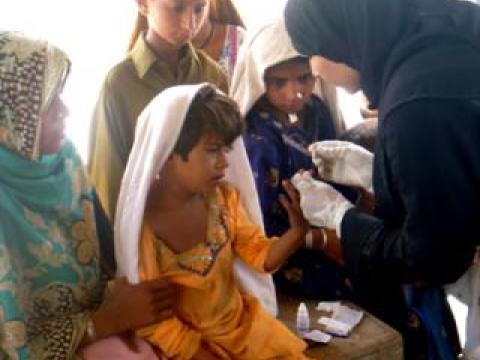News: Pakistan villages bear brunt of more flooding- World Vision medical staff respond

On the sandy plains of Sindh in Ghotki, 90 kilometres from the town of Sukkur, families of the poorest of the poor have again been rendered homeless and stripped of their livelihoods as their fields turn into muddy swamps. An additional 30 villages, totaling some 30,000 people, are at risk of flooding. And, if the monsoon brings more rain than predicted, the plains of Sindh and Punjab could see another devastating flood similar to the one that destroyed millions of homes in Pakistan in 2010.
“Our children and pregnant women cannot survive without external help”, said community leader Haq Nawaz to World Vision staff.
The community has hardly recovered from the previous floods and we have been hit againHere, World Vision’s mobile health clinic is the only source of medical care in this remote area and staff are treating around 100 patients daily – mostly women and children- suffering from malaria, scabies, diarrhea, and malnutrition. The medical team is also treating people remaining in the 30 nearby villages.
Lal Khatoon, a five-year-old girl from inundated Habibullah village would have died from malaria if she had not received urgent treatment from World Vision medical staff.
According to World Vision reports the two villages of Habibullah Chachar & Yousif Chachar comprising 327 households have been completely submerged along with its schools and agricultural fields and 40 more villages, totaling some 30,000 people, are under serious threat.
While men and women build mud shacks with leaves and branches to protect themselves from the scorching sun and temperatures reaching 51degrees Celsius, children run around the river banks totally oblivious to the calamity which has hit them.
“The floods have never been so bad”, said Lal Khatoon, an elderly woman displaced by the recent floods.
Lal Khatoon has not only lost her home but also any semblance of hope. Last year in 2010 she lost everything in Pakistan’s worst ever flooding. “The community has hardly recovered from the previous floods and we have been hit again”, she laments. Her community, she said, was absolutely helpless and required food and tents to survive the intense heat. She was full of fears as the monsoon rains have yet to fall and play havoc with the population of Gothki.
The villagers are so poor that they cannot afford to come to us and hence we try to get to their far flung villages to provide them with the medical support they needCommunity leader Haq Nawaz says impoverished villagers have no resources left and have no money to move to a safer place. The people, he said, were in dire need of food and shelter, a fact made clear as hungry children, women and men sat wherever they found an inch of shade under any tree or shack.
Nearby the river bank in a mud brick hut, women and children crowd around to receive free medicines and treatment from World Vision’s mobile clinic.
“The villagers are so poor that they cannot afford to come to us and hence we try to get to their far flung villages to provide them with the medical support they need”, said Dr. Sikandar of World Vision.
“Without World Vision and outside help we cannot fight disease and hunger”, said Haq Nawaz. “We are thankful to World Vision for coming here first like last time in the 2010 floods”.
World Vision assisted more than 900,000 people in 11 districts of the Khyber Pakhtoonkhwa, Punjab and Sindh provinces following the 2010 floods. In addition to providing medical care through mobile teams like the one in Ghotki, World Vision staff distributed food and emergency household supplies, provided water purification packets to ensure clean drinking water for families and gave children safe spaces in which to play and receive an informal education. Through its relief, development and advocacy work, World Vision Pakistan is striving to ensure children are educated for life, enjoy good health and are cared for, protected and participating in their communities.
-Ends-
*Pakistan has one of the highest child and maternal mortality rates globally. Under-five mortality (94/1000) is the highest in South Asia, except Afghanistan. Among neonatal deaths (children aged less than one month), 74 per cent die in the first week of life.
Poor nutrition due to extreme poverty is an underlying factor in under-five deaths in Pakistan. In flood-affected areas in Sindh, acute malnutrition rates are reported at 22.9 per cent and 6.1 per cent severe malnourishment in children under five.